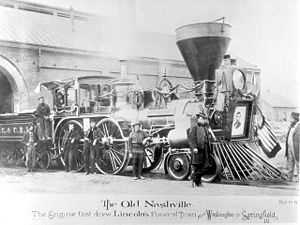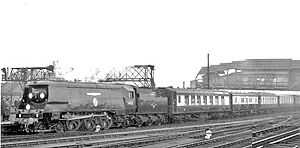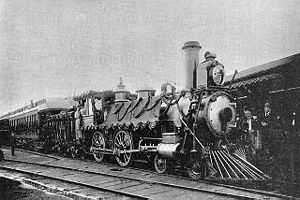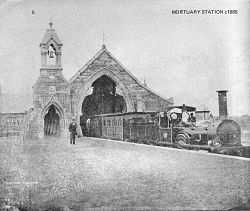Funeral train

A funeral train is a train specially chartered in order to carry a coffin or coffins to a place of interment. Funeral trains today are often reserved for leaders and national heroes, as part of a state funeral, but in the past were sometimes the chief means of transporting coffins and mourners to graveyards. Funeral trains remain mostly steam locomotive hauled, due to the more romantic image of the steam train against more modern diesel or electric locomotives.
History
The first funeral train was run by The London Necropolis and National Mausoleum Company on 7 November 1854. Trains ran once a day from London Necropolis railway station to Brookwood Cemetery. The train carried not only the bodies of the dead, but the parties of mourners who had come to attend the funeral services. Different classes were available for both the living and the dead; a more expensive first class ticket would provide a more ornate coffin and greater care of the body during transit. The London Necropolis Railway was run on the tracks of the London and South Western Railway, who feared that regular passengers would shun locomotives which had previously hauled funeral trains, and therefore purchased an entirely new fleet exclusively for the Necropolis line. The public were initially reserved about the project; one bishop expressed fears that "It may sometimes happen that persons of opposite characters might be carried in the same conveyance. For instance, the body of some profligate spendthrift might be placed in a conveyance with the body of some respectable member of the church, which would shock the feelings of his friends".[1] Others felt that the railway industry, which was less than 20 years old and still very much a new technology, was too hectic and loud, ill-befitting the sombre mourning associated with Christian funeral services.
The line ran daily – including Sundays – for almost 50 years until 1900, when the Sunday service was stopped and trains began to run on an "as needed basis". The railway remained in operation through the First World War and Second World War until 16 April 1941, when the London Necropolis station was bombed in the London Blitz. The station was never rebuilt and the line fell into disuse.[2]
When West Norwood railway station opened two years later it was sited near to the gates of South London Metropolitan Cemetery, founded twenty years earlier; pall-bearers would unload the coffin from its "Funeral special" and simply carry it from the side entrance to the main gates. While this practice is long discontinued, the side gates still remain.
Australia
In Sydney, Australia, there was a similar service whereby the Rookwood Cemetery railway line served the Rookwood Cemetery complex. From 1867 until 1948 trains would depart Mortuary Station in Sydney City and travel the 15 km to Rookwood Cemetery.[3]
In Melbourne funeral services operated to the Springvale Necropolis along the dedicated Spring Vale Cemetery railway,[4] while the Fawkner Cemetery was served by trains to Fawkner station.[5]
Finland
In Helsinki, a 2 km long side track ran from the Malmi railroad station to the Malmi cemetery, which had its own railroad station. Coffins were transported to the cemetery from Harju morgue in Kallio. The track was decommissioned in 1954, and has been removed, but the Malmi cemetery station building still exists.
Germany
The Berlin Friedhofsbahn (Cemetery Line), opened in 1913, ran from Berlin-Wannsee station to Stahnsdorf's Forest Cemetery, about 20 kilometres southwest of Central Berlin. It was serviced by both funeral trains with passenger and hearse carriages, as well as regular S-Bahn (suburban rail) services. Funeral train service ended in 1952 and the construction of the Berlin Wall in 1961 spelled the end for cross-border S-Bahn services.
State funerals

Although most funeral services now make use of road-going hearses rather than trains, funeral trains remain common for the funerals of heads of state.
UK: All British monarchs since Queen Victoria have been carried by funeral trains; King Edward VII and King George VI were both taken to the Windsor & Eton Central railway station for the funeral procession. Most British Prime Ministers do not receive funeral trains. However, as part of his state funeral, Winston Churchill's coffin was carried by the Southern Railway "Battle of Britain" class locomotive Winston Churchill to Blenheim Palace.[6]
Russia: In 1894, the body of Tsar Alexander III, was transported by train from Livadia Palace in the Crimea, back St. Petersburg, by way of Moscow. On January 23, 1924, body of Vladimir Lenin was carried by funeral train to Moscow Paveletskaya railway station. Later Museum of Lenin Funeral train was established in the rail terminal building.[7] This is now the Museum of the Moscow Railway.
In the USA Presidents are also sometimes transported by train; Abraham Lincoln (April 1865), Franklin D. Roosevelt, and Dwight D. Eisenhower were all given funeral trains as part of the procession. More recently, Senator Frank Lautenberg of New Jersey, an advocate of public transit and Amtrak, was transported from New Jersey to Washington on the North East Corridor following his death.[8]
Canadian Prime Minister Sir John Alexander Macdonald (Canadian Pacific Railway), John George Diefenbaker and Pierre Elliott Trudeau (Via Rail) had their bodies transported by train.
Gallery
-

John A. Macdonald's funeral train.
-
Van 1691 Lenin's Funeral Van at the Museum of the Moscow Railway at Paveletsky Rail Terminal, Moscow
-
Lenin's Funeral locomotive U-127, at The Museum of the Moscow Railway, Paveletsky Rail Terminal
-
Lenin's Funeral locomotive U-127, at The Museum of the Moscow Railway, Paveletsky Rail Terminal, Moscow
-
Lenin's funeral wreaths in his funeral van at the Museum of the Moscow Railway
References
- ↑ The Deathline - Fortean Times (Registration required). URL accessed 11 November 2006
- ↑ The Cemetery Railway. URL accessed 11 November
- ↑ CityRail, Welcome to Central Station
- ↑ "Our Beginnings - Welcome to Springvale Botanical Cemetery". www.necropolis.net.au. Retrieved 2008-08-16.
- ↑ "Fawkner Crematorium & Memorial Park : Restored Mortuary Carriage". www.fcmp.com.au. Retrieved 2008-08-24.
- ↑ The Churchill Project Appeal. URL accessed 11 November 2006
- ↑ Мемориальный паровоз У-127 (Russian). URL accessed 13 November 2007
- ↑ NJ.com. URL accessed 31 December 2013
External links
| Wikimedia Commons has media related to Funeral trains. |




